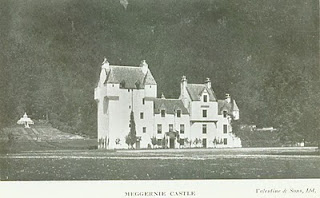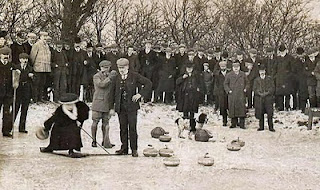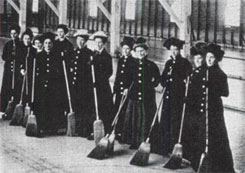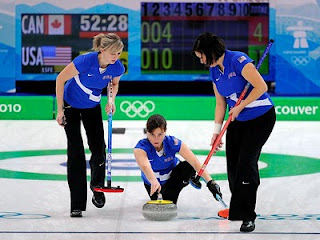In honor of the upcoming summer Olympics in London, here is a blog I wrote in November of 2010 when the Vancouver winter Olympics were underway. Juliette “Daisy” Low loved being physically active, and she never shied away from athletic competitions, especially among good friends, and even if the sport was considered a “man’s sport.” But curling?! Yes, even curling!
________________
Daisy Low adored Scotland—all of it: the people, the scenery, the culture, the cities, and especially the Highlands. She fell in love with the country before she wed Willy Low, but after she was married she got to spend three months in Scotland every fall for the long hunting season. Daisy and Willy leased two different hunting lodges in the Highlands where they entertained their friends. After Willy’s death, Daisy was always happy for any occasion to return to Scotland.
While I don’t know of her ever attempting to play the bagpipes, she did catch salmon and brown trout in Scotland. But more than that, Daisy enthusiastically embraced the Scottish national pastime of curling. Here’s what she wrote to her brother Arthur’s wife, Margaret Gordon:
“[A]ll day we curl on the ice. Arthur knows what curling is—big stones with handles which we hurl over the ice and the game is like bowls.”
She wrote that from her bedroom in Meggernie Castle, in Perthshire, which is located in central Scotland right on the edge of the Highlands. It was owned at the time by Scottish textile magnate John Bullough. Daisy thought there was almost nothing as breathtaking as Meggernie in the snow. “It looks like what we used to read in fairy tales of turreted castles,” she told Margaret, “and at night the moon (now full) transforms it into a dream of beauty.” [i] At Meggernie in the winter there was dancing, skating, hiking, horseback riding, and curling.
Curling was probably created in Scotland sometime in the sixteenth century. It was played for fun generally with two teams of four players, and eight stones. Each player slid two stones to one end of the ice. They had a brush or a broom that helped to clear the ice of debris. The team with the most stones closest to the target won. (This is a very abbreviated version of the rules!) The stones were heavy (25-44 pounds) and necessitated some arm strength. Curling was a collegial game, especially when played by castle guests who, after hours on the ice, were no doubt glad to come in from the cold and trade their stones and brooms for a scotch and a seat beside a roaring fire.
Women did not begin to curl competitively in Scotland until the late nineteenth century, when the first women’s curling clubs were established. One hundred years later, in 1998, curling became an Olympic sport. Today there are female curlers in Scotland and the U.S. and many other countries, especially Canada, where Scottish immigrants introduced the game.
Daisy enjoyed curling so much, she would no doubt be thrilled to see the sport gaining in popularity as a result of the heightened publicity from the Olympics. Girl Scouts and Girl Guides can try curling at Our Chalet, the World Association of Girl Guides and Girl Scout camp in the Swiss Alps. If you know of any other Girl Scout or Girl Guide connections to curling, I hope you’ll let us know about it by commenting on this blog!






For the past 3 years, Girl Scouts of Eastern Massachusetts has had an Intro to Curling program hosted by Broomstones Curling Club in Wayland, MA. This year, I was able to share this information with the 50+ girls who participated!
Thanks for the great story to tell!
Karen–I am so glad that this was of help! I love this story about Daisy and curling. Thanks for writing1
Thank you for your great story. Doing genealogy with my Mom and found we had Scottish ancestors. Was fun to see where Juliette stayed. Did she own any of the Scottish castles?
Thank you,
Mary Kay Herma
Thanks for your comment, Mary Kay, and thanks for reading. No, Juliette Low never owned a castle.